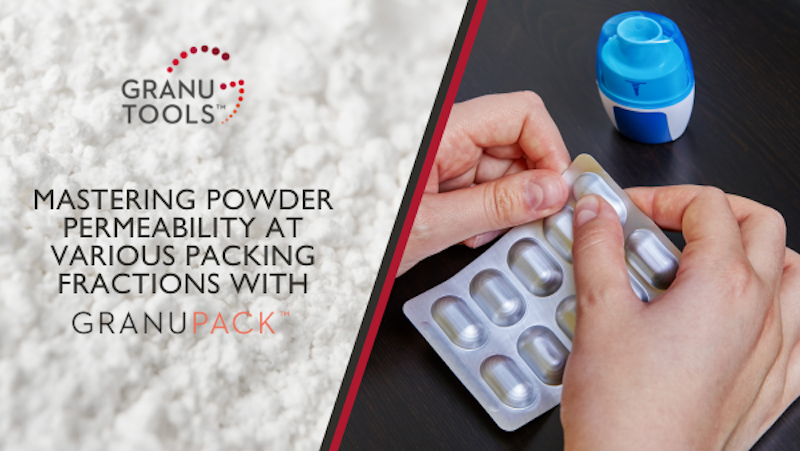Members Login

Channels
Special Offers & Promotions
Mastering Powder Permeability at Various Packing Fractions with GranuPack
Permeability in pharmaceutical processes
Powders are used in all production processes of solid dosage forms like tablet or dry powder inhaler (DPI) manufacturing processes. Among all the powder properties, permeability, which is the capacity of a fluid (air) to pass through a powder bed, plays a crucial factor in different pharmaceutical processes. In the die filling of tablet manufacturing, the permeability determines the powder flowability during the displacement of the powder within the die and the capacity of the powder to pack in the die. The easier the capacity of air to permeate the powder, the more efficient the powder packing in the die and consequently the quality of the final tablet in terms of weight uniformity, packing fraction, tensile strength, disintegration, and dissolution behavior of the tablet. In DPI, the permeability influences the effective dispersion and release of the inhalation mixture. Permeability must be not too high to improve the dispersion forces within dry powder inhalers during aerosolization but not too low in order not to reduce the DPI performance.
Permeability measurements
Permeability depends on the packing fraction. Indeed, the larger the packing fraction of the powder, the closer the particles and the lower the permeability. However, a powder can be densified due to vibration or flow during a manufacturing process. Depending on the densification properties, the permeability classification between different powders can change. Consequently, it is very important to measure the permeability in similar packing conditions, close to those of the process.
Many instruments allow measuring the permeability, but only at specific packing conditions, that do not necessarily correspond to the ones of the pharmaceutical process. Therefore, an instrument, able to measure the permeability at different packing fractions is needed. By doing so, it is possible to understand the real powder behavior and prevent process issues, like tablet weight variations, e.g. by selecting proper powder formulations.
Permeability measured with the GranuPack
Standard methods to measure the tapped density have some limits like the tube filling method and the naked eye volume measurement, which depend on the user. To overcome these limitations, the GranuPack (Granutools), an improved tapped density instrument, has been developed. In addition to the initial density and the final density after a specific number of taps, it allows to have access to the whole packing curve, that is the bulk density as a function of the number of taps, providing information about the packing dynamics. The precise initialization protocol coupled with an automatic powder height measurement allows good repeatability and precision in the results.
The GranuPack associated with a specific permeability cell is a highly versatile instrument allowing the measurement of many physical parameters due to the association of the classical GranuPack packing measurement with the permeability. By combining the tapping mechanism, which allows to reach different packing fractions, and the permeability cell, which allows the air to pass through the powder bed, it is possible to know the evolution of permeability with the increase of the packing fraction. Knowing how permeability changes with densification allows us to gather useful information on powder behavior for the improvement of pharmaceutical processes.
Media Partners



